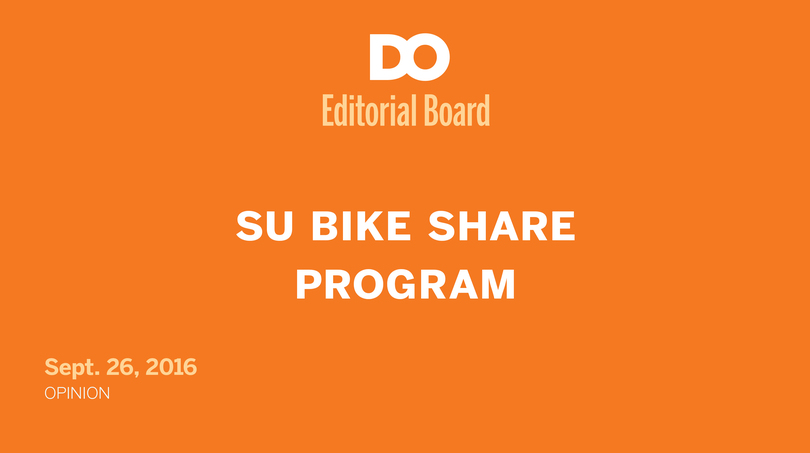SU bike share program merits kiosk, resource expansion

/ The Daily Orange
One week after its confirmation by the Student Association, the Syracuse University bike share program will available starting Monday at the Schine Student Center. But proposed in 2014 as a means of providing free, temporary transportation to students, the path to realizing the bike share program has been a long and bumpy road.
Since the idea was introduced, the premise has been that students would sign a liability waiver and agreement form to take out a bike. Bikes are allotted to students for 24 hours at a time — or for the weekend with Friday rentals — and can be accessed free of charge.
After input from sustainability and transportation departments and a planning process that spanned three SA administrations, the bike share program will finally be up and running. But while students see progress in action as Eric Evangelista and Joyce Lalonde take the reins from Jane Hong and Aysha Seedat on this initiative, there is room for improvement through expansion.
In 2014, the plan was to have two kiosks: one at Archbold Gymnasium and one at Manley Fieldhouse. The pilot program from the following year was based out of Archbold. Now, providing bikes at Schine not only make sense in terms of a centralized location on campus, but also in terms of increasing the status of Schine as the university’s student center.
Within the campus community, students living in residence halls are a few minutes from other Main Campus locations, but students housed on South Campus travel at the mercy of the 344 bus. If Archbold proves difficult during renovations, adding a kiosk at Goldstein Student Center would help these students tremendously. Having this option would not only help students travel about South, but also give them a way to travel from home to Main Campus at their own pace.
The number of bikes themselves, too, should be expanded. In 2014, project analyst Rick Martin pointed to the problem of supplying bikes as a reason for the program’s late start. Local store Mello Velo Bicycle Shop has now supplied bikes, bumping up the six from the 2015 pilot program up to eight with two back-ups.
Starting with just 10 bikes now is smart, as it ensures that money isn’t wasted on an unsuccessful program. But realistically, a maximum of 10 bikes in rotation will not be enough to fully accommodate a student body of 20,000.
Of course, like the trial period before it, this phase of the bike share program should be about gauging interest and making changes accordingly. One factor of that SA should keep in mind is that changing seasons might hold SU students back from renting out bikes. Fall has officially started and winter is coming, and these conditions in Syracuse aren’t necessarily conducive for a weather-dependent program.
Still, it’s clear the bike share program is on the right path. When the opportunity kicks off on Monday and as it continues throughout the semester, SA should continue to stride ahead and ride its wave of productivity to move full speed ahead with expanding this much-needed student program.




